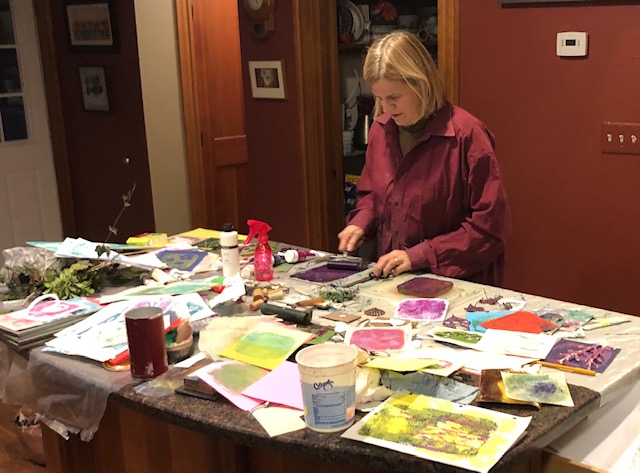
Joan Carroll will be the presenting artist for January’s online guild meeting. She will do a demonstration of a gelatin printmaking process, an easy nontoxic method of creating images that resemble photographic negatives. Viewers may work along with Joan, following her instructions to create their own prints. The recipe for creating the gelatin block is included below. Block must be made and gelled in advance of the demo if you would like to try the process. This form of mono-printing can be complex or extremely simple and can serve as a fantastic printmaking introduction for children. Other media can be used along with the basic process. Watercolor may be applied to the printing paper in advance. Media, such as drawing ink, pencils, and pastels can be introduced after printing.
Materials needed to print will include:
- gelatin block on which to roll out water base ink, water-based oil printing ink can also be used, though I have not tried it. Recipes below, Recipe 3 uses isopropyl alcohol and a smaller proportion of glycerin. I have used a recipe without glycerin, but the block was fragile and deteriorated with use.
- a clean cookie sheet or clean plastic surface like cutting board on which to sit the gelatin block. Block can be stored in a fridge and reused many times.
- water-based block printing ink, possibly in more than one color to create overlapping images, to provide variety, and to blend colors
- opt. flat surface such as a linoleum tile or cleaned styrofoam meat tray on which to roll out the ink
- ink roller
- variety of found objects, see list below
- paper for printing – all kinds possible, but I like, printing paper, rice paper, white drawing paper or newsprint. More absorbent papers pick up fine details better.
Recipe for making the gelatin plate:
- I highly recommend watching the video about the specific recipe you choose or watch all of them. Each recipe has different instructions based on ingredients. See links below.
- Glycerin is expensive, about $9 for 6 oz. bottle at CVS, but is much cheaper on-line.
- Mix ingredients in very clean glass Pyrex containers, flat bottom, no raised logo on inside or bevel
- The gelled plate will be transferred onto a very clean metal cookie sheet or a plastic hard surface… If during printing, the gelatin block surface develops dents, the block can be microwaved and re-gelled.
Recipe 1
yields 9 by 12 pan gelli plate
Build Your Stash and Craft by al John
Step 1: Pour 2 cups of glycerin in a container and sprinkle in 8 packages of gelatin. Stir gently.
Step 2: Add 2 cups of hot (boiling) water. Gently stir until the gelatin has dissolved.
Recipe 2
yields 5 by 7 gelli plate
CraftTestDummies
Box of 4 pks of Knox gelatin
2/3 c cold water
1 6 oz. glycerin bottle
1/3 c boiling water
Recipe 3
Very small round pyrex size (smells like alcohol and may eventually mold)
Homemade Gel Plate, Janelle Nichol
1 1/4 T gelatin
1/4 C water
1/8 isopropyl alcohol
1/8 C glycerin
Possible Materials for Printing
From your home: Embroidery floss, thread, flat metallic objects like washers, rubber bands, and metallic alphabet/number stickers, pencil, paper clips, ponytail holders, crumpled tissue paper, rubber stamps, lace or paper doilies, round hole punch reinforcements, art stencils, and alphabet stencils. You can also cut shapes from index cards.
From nature: Blades of grass, delicate flowers, leaves, stems, petals, soft twigs, and pine fronds, shells, seaweed
Websites on Gelatin Printing
https://www.youtube.com/watch?v=TgiGfDZGrWE
https://www.youtube.com/watch?v=XsLjJYsOsio
https://www.youtube.com/watch?v=Rw6PAOapdp8






